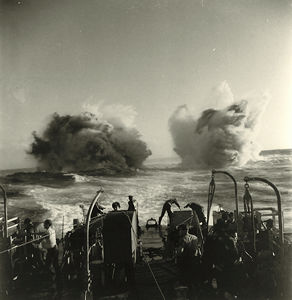The Battle of the Atlantic was the longest battle of the Second World War. It lasted between 3 September 1939 and 8 May 1945. The Atlantic Ocean was important for the Allies because they needed to send supplies and people by ship from North America to Europe. German U-boats (submarines) attacked and sank many of these ships. Canada played an important role in the Battle of the Atlantic. The Canadian navy and air force protected convoys of supply ships and hunted U-boats. The Canadian merchant navy transported troops, food and other supplies.
(This is a plain-language summary of the Battle of the Atlantic. If you are interested in reading about this topic in more depth, please see our full-length entry, Canada and the Battle of the Atlantic.)

The Battle Begins
On 3 September 1939, Britain formally declared war on Germany. The same day, a German submarine sank the SS Athenia off the coast of Ireland. The Athenia was a passenger ship headed to Montreal; 112 people died, including four Canadians. This was the start of the Battle of the Atlantic. German Admiral Karl Dönitz thought Germany could win the war if they could stop the Allies shipping supplies and people to and from Europe.
Canada’s Role
Canada declared war on Germany on 10 September 1939. The Canadian navy, merchant navy and air force were soon involved in the Battle of the Atlantic. Canada’s main role was escort duty for convoys of merchant ships. The convoys sailed from the ports of Halifax and Sydney, Nova Scotia, and from St. John’s, Newfoundland (which wasn’t part of Canada yet). The first convoy left Halifax on 16 September 1939. It was escorted by British cruisers and two Canadian destroyers.
Canada’s navy was small when the war started. So, the Canadian government had to build ships and train men (and women). By the end of the war, it was the fourth largest navy in the world. Canada built a lot of small warships called corvettes. They were smaller than destroyers and were quicker and cheaper to build. The corvettes took on a large portion of the convoy duties. Canadian pilots also helped protect the convoys. Seven squadrons of the Royal Canadian Air Force were part of the Royal Air Force Coastal Command.
German Successes 1939-42
Early in the war, German U-boats were winning the battle. They hunted convoys in wolf packs: if a submarine spotted a convoy, the call would go out to the rest of the pack. They would then attack at the same time, usually at night. Between March and September 1942, U-boats sank almost 100 merchant ships a month. Many of the attacks took place in the mid-Atlantic, which was beyond the reach of Allied aircraft.

The Tide Turns
By 1943, though, the situation had changed. British intelligence could decode German messages and figure out where the U-boats were headed. They also had new long-range planes that could protect convoys across the Atlantic. Britain’s Royal Navy also organized its best anti-submarine ships into groups that hunted U-boats.
Canada expanded its escort duties and sent ships to help protect British ports. The Canadian navy also formed its own hunter groups, which was made up of new frigates. Between November 1943 and spring 1944, Canadian ships sank eight U-boats.
In 1943, U-boats sank fewer than 300 merchant ships. This was one-quarter of the number they had sunk in 1942. However, they were still a serious threat. By 1944, they could travel farther underwater. They also had new torpedoes that could home in on the sound made by a ship’s propellor. In the last year of the war, eight Canadian warships were sunk and four were badly damaged.
Merchant Navy
The merchant navy helped win the Second World War. Canadian merchant ships made over 25,000 voyages from North America to Britain. They carried almost 165 million tonnes of military and civilian supplies. About 12,000 served in Canada’s merchant navy, which grew from about 40 to 400 ships. Nearly 60 Canadian merchant ships were sunk during the Battle of the Atlantic.

Casualties
More than 36,000 Allied sailors, soldiers and airmen and 36,000 merchant seamen died during the Battle of the Atlantic. This included about 2,000 members of the Royal Canadian Navy and about 750 Canadian airmen. More than 1,600 members of the Merchant Navy were killed. Civilian passengers died as well. About 30,000 German sailors died during the Battle of the Atlantic.

 Share on Facebook
Share on Facebook Share on X
Share on X Share by Email
Share by Email Share on Google Classroom
Share on Google Classroom








